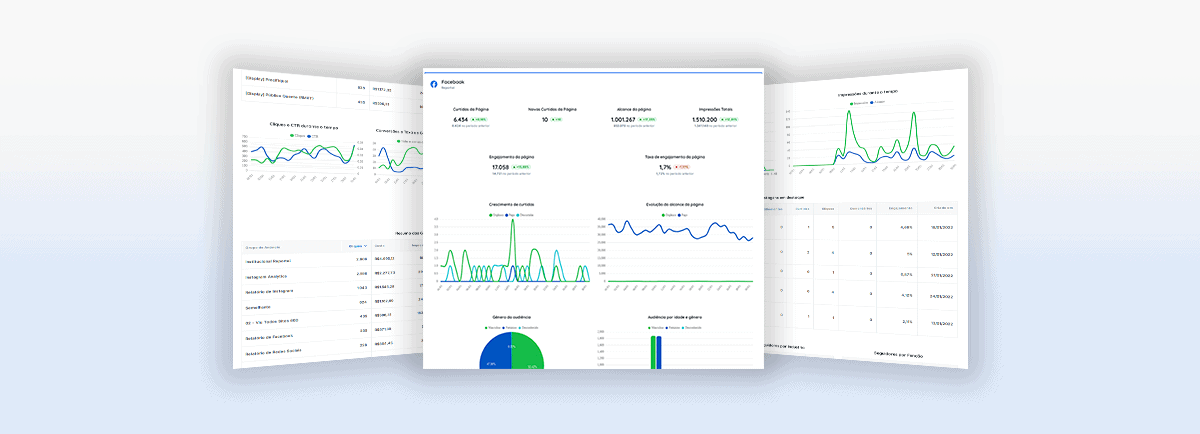Check out 5 marketing report templates available on Reportei and learn how to analyze results more efficiently
We always talk about how important it is to use digital marketing reports, which should show relevant results, engage clients, and give you insights for the next campaigns.
But how can you do that? What should you include in the layout? While there isn’t a recipe, some report templates can help you develop more strategic reports.
In this article, we’ve selected five marketing report templates in Reportei to give you visuals of the most relevant information for each type of service. We’ll also cover how to analyze data from different periods (daily, weekly, and monthly). Keep reading!
5 Marketing Report Templates
First, it’s important to remember that every digital marketing service should have a goal, which helps guide meetings with clients.
For instance, decision-makers may be interested in social media engagement, but if their project is inbound and the goal is to increase sales, they’ll first want to know what your strategies are doing for the funnel-bottom and whether they’re successfully generating opportunities.
So, the report or dashboard should lead story-telling by highlighting the most relevant results of a period. We call this the inverted funnel.
To make it easier, Reportei templates are organized according to four major niches in digital marketing (social media, inbound, paid traffic, and e-commerce). You can also customize them for more specific layouts.
Check out the details below, and find out how to create your own unique report. Let’s get started!
Social Network Reports
Also known as our standard template, this was Reportei’s first report template. It prioritizes the results of social media actions in individual projects.
In other words, engagement, profile growth, and content that performed better in the period analyzed. It’s perfect for those whose project goals are managing Instagram, Facebook, TikTok, Pinterest, and other social channels integrated with Reportei.
That doesn’t mean they’re the only networks to show up in your report. You’ll find data from paid media channels, SEO, automation, and any others you’d like to add below.
And like any other marketing report template mentioned in this article, there’s lots of ways you can customize social media templates (adding text or image analyses, rearranging metrics, adding new data, etc).
Inbound marketing reports
If your project is centered around inbound, layouts should emphasize the bottom-of-the-funnel results.
Let’s say you use RD Station for marketing automation to generate business leads for your clients. Shouldn’t these results come first?
That’s just what our inbound marketing template does. It focuses on automation and CRM platforms, then paid media data (perfect for this type of strategy), site performance, and other middle and funnel-top channels.
Paid traffic reports
If you’re working on projects that include or are focused on paid traffic, prioritize the platforms where you run those ads and the return on investment.
Our templates highlight Google Ads, Facebook Ads, LinkedIn Ads, TikTok Ads, and Pinterest Ads, and you can build them around platforms with the best results (or that your client considers the most relevant).
Next are Google Analytics metrics, automation tools, and overall social media results.
E-commerce reports
E-commerce projects often require a specific approach since it’s a self-service sales process and generally more fast-paced than other niches.
So, digital marketing reports should track the website’s sales performance through key metrics like revenue, conversion rate, cart abandonment rate, and other relevant data.
Our e-commerce report makes that easy. It shows Google Analytics metrics first, with an emphasis on e-commerce metrics. General website data follows, then, paid media channels (essential to any e-commerce business), social media content, and automation platforms.
Customizable reports
If your digital marketing project doesn’t fit into any of the templates we’ve listed above, don’t worry! You can create a custom report or dashboard tailored to your client’s needs using the inverted funnel approach (mentioned earlier).
You can customize layouts as you like, too:
- rearranging, deleting, or modifying any metrics, graphs, or tables as needed;
- adding any relevant data;
- Rearranging the channel order.
Once you’ve created your custom template, you can save it and use it again when you’d like, and allow your client to access the most relevant and impactful reports for more informed decision-making.
Check out some tips for analyzing your results
Now that you’ve had a chance to review our suggested marketing report templates, here are some tips to help you streamline your daily, weekly, and monthly analyses. Keep reading!
Daily
Daily analyses are usually done to help you stay on top of a project’s performance and identify issues that require immediate attention. For instance, you may want to check website performance, spot issues with ads that are running, or check anything else that needs immediate attention.
A dynamic dashboard with real-time results is the best way to make decisions as needs arise.
Weekly Reports
These should give you an overview of performance, budget control, and other relevant project data.
Say your goal is generating a certain number of opportunities for your client each month. You can track your progress weekly to gauge whether you’re on the right track and gain valuable insights for planning. The same goes for other indicators that directly affect your goal.
To create an effective marketing report, you can use dashboards or generate static reports. If you use Reportei, you’ll also be able to use the Indicators Control tool, which monitors key metrics and notifies you when you reach your goal, fall short, or exceed expectations.
Monthly Reports
Your monthly reports should summarize what you worked on throughout the month to reach the project’s goals. It should also include insights for the next steps.
This report covers the most relevant metrics for each channel and is typically shared and discussed with clients or decision-makers. You can use it for project story-telling, to provide context, discuss any challenges that may have come up, and plan ahead.
Documenting is a very important part of reporting to and keeping clients engaged and playing an active role in decision-making.
Generate more strategic marketing reports with Reportei!
Whether you need different templates, monthly, weekly, or daily reports, Reportei offers solutions that seamlessly fit into your project’s routine so you can analyze results more strategically.
Start your free, 3-day trial for a much more productive digital marketing routine!





